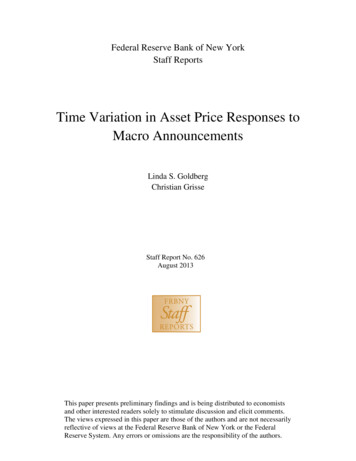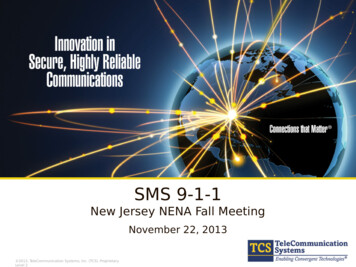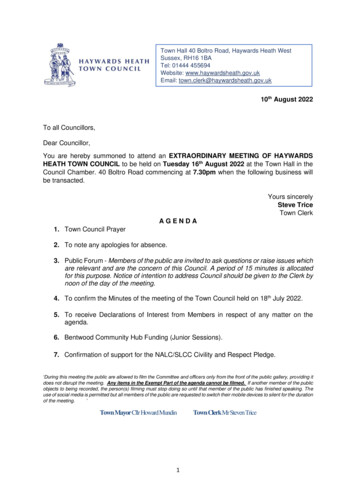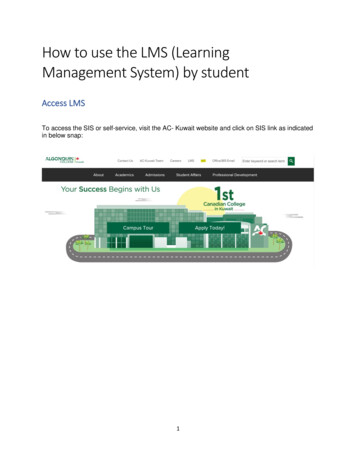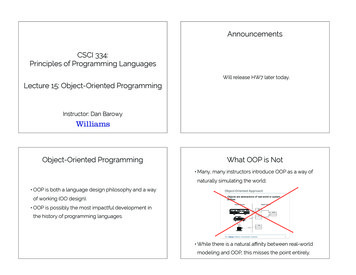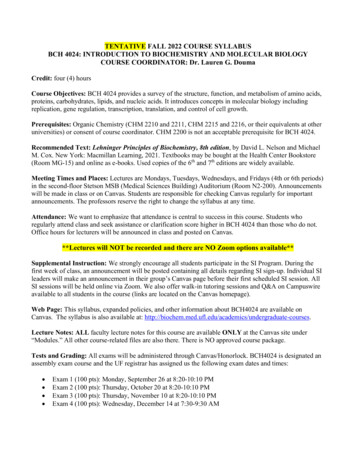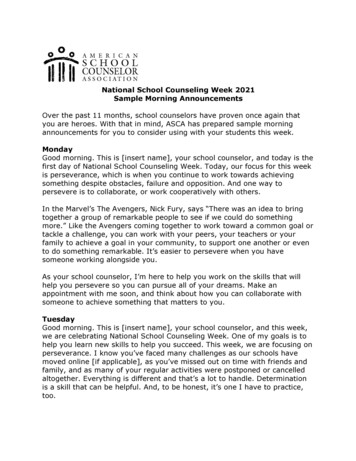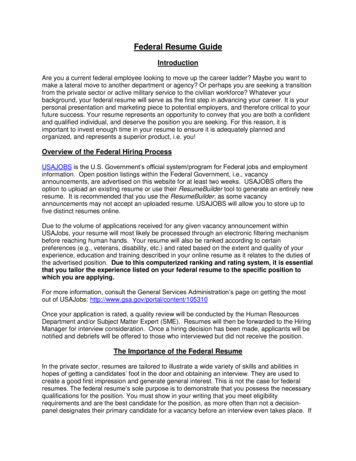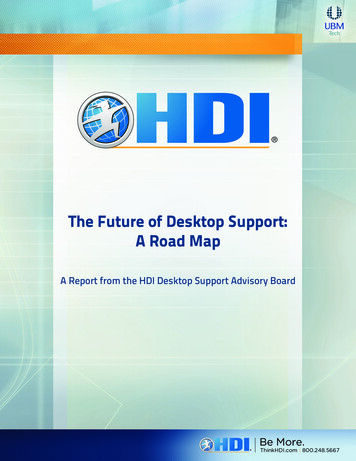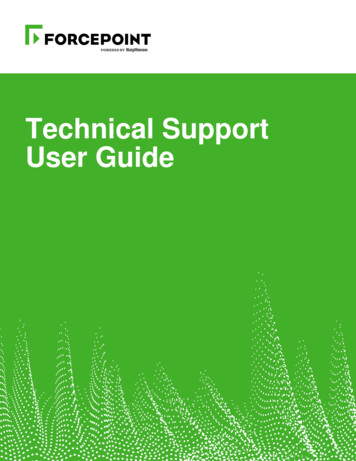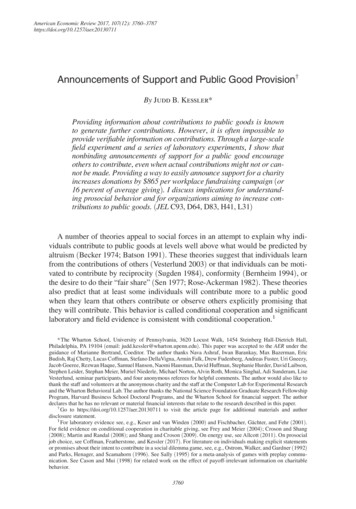
Transcription
American Economic Review 2017, 107(12): ouncements of Support and Public Good Provision†By Judd B. Kessler*Providing information about contributions to public goods is knownto generate further contributions. However, it is often impossible toprovide verifiable information on contributions. Through a large-scalefield experiment and a series of laboratory experiments, I show thatnonbinding announcements of support for a public good encourageothers to contribute, even when actual contributions might not or cannot be made. Providing a way to easily announce support for a charityincreases donations by 865 per workplace fundraising campaign (or16 percent of average giving). I discuss implications for understanding prosocial behavior and for organizations aiming to increase contributions to public goods. (JEL C93, D64, D83, H41, L31)A number of theories appeal to social forces in an attempt to explain why individuals contribute to public goods at levels well above what would be predicted byaltruism (Becker 1974; Batson 1991). These theories suggest that individuals learnfrom the contributions of others (Vesterlund 2003) or that individuals can be motivated to contribute by reciprocity (Sugden 1984), conformity (Bernheim 1994), orthe desire to do their “fair share” (Sen 1977; Rose-Ackerman 1982). These theoriesalso predict that at least some individuals will contribute more to a public goodwhen they learn that others contribute or observe others explicitly promising thatthey will contribute. This behavior is called conditional cooperation and significantlaboratory and field evidence is consistent with conditional cooperation.1* The Wharton School, University of Pennsylvania, 3620 Locust Walk, 1454 Steinberg Hall-Dietrich Hall,Philadelphia, PA 19104 (email: judd.kessler@wharton.upenn.edu). This paper was accepted to the aer under theguidance of Marianne Bertrand, Coeditor. The author thanks Nava Ashraf, Iwan Barankay, Max Bazerman, EricBudish, Raj Chetty, Lucas Coffman, Stefano DellaVigna, Armin Falk, Drew Fudenberg, Andreas Fuster, Uri Gneezy,Jacob Goeree, Rezwan Haque, Samuel Hanson, Naomi Hausman, David Huffman, Stephanie Hurder, David Laibson,Stephen Leider, Stephan Meier, Muriel Niederle, Michael Norton, Alvin Roth, Monica Singhal, Adi Sunderam, LiseVesterlund, seminar participants, and four anonymous referees for helpful comments. The author would also like tothank the staff and volunteers at the anonymous charity and the staff at the Computer Lab for Experimental Researchand the Wharton Behavioral Lab. The author thanks the National Science Foundation Graduate Research FellowshipProgram, Harvard Business School Doctoral Programs, and the Wharton School for financial support. The authordeclares that he has no relevant or material financial interests that relate to the research described in this paper.†Go to https://doi.org/10.1257/aer.20130711 to visit the article page for additional materials and authordisclosure statement.1For laboratory evidence see, e.g., Keser and van Winden (2000) and Fischbacher, Gächter, and Fehr (2001).For field evidence on conditional cooperation in charitable giving, see Frey and Meier (2004); Croson and Shang(2008); Martin and Randal (2008); and Shang and Croson (2009). On energy use, see Allcott (2011). On prosocialjob choice, see Coffman, Featherstone, and Kessler (2017). For literature on individuals making explicit statementsor promises about their intent to contribute in a social dilemma game, see, e.g., Ostrom, Walker, and Gardner (1992)and Parks, Henager, and Scamahorn (1996). See Sally (1995) for a meta-analysis of games with preplay communication. See Cason and Mui (1998) for related work on the effect of payoff-irrelevant information on charitablebehavior.3760
VOL. 107 NO. 12Kessler: Announcements of Support and Public Good Provision3761But to what extent can social forces explain the pattern and amount of public goodcontribution observed in practice? Verifiable information about others’ actions orothers’ explicit promises to contribute (e.g., through a pledge) is often unavailable.If these are necessary to influence behavior, social forces are likely to have limitedimpact. If individuals additionally respond to announcements of support that mayor may not be associated with an actual contribution, then such social forces may becapable of generating public good provision more broadly. Indeed, announcementssupporting a public good—made without proof or a promise of contribution—arewidespread. They include posts on social media, petition signatures, yard signs,bumper stickers, worn apparel, and ubiquitous verbal and written statements supporting a charity, candidate, or cause.Do such announcements of support affect the contributions of others even thoughthey could be cheap talk? This paper finds that individuals respond to announcements of support and that the effect of announcements can be large in magnitude. Itanalyzes results from a large-scale field experiment, conducted with the local branchof a major national charity, and two complementary laboratory experiments. In allexperiments, some subjects are given a way to announce support for a charity to others, and subjects exposed to such announcements of support make larger donations.2In the field experiment, workplace fundraising campaigns were randomly selectedto receive a bag of pins (i.e., buttons) along with other campaign materials providedby the charity. The pins were printed with “I Support” and the charity name andlogo. The “I Support” language was chosen to avoid referencing a specific actionor making an explicit promise. The employee running each workplace campaignwas instructed to give pins to his or her coworkers and to encourage them to wearthe pins around the office before donations were made. A two-stage least squaresestimation strategy finds that pin use in a workplace campaign increases donationsby an average of 865 per workplace (a 16 percent increase on a mean of 5,341 perworkplace). Each 0.17 pin sent to a workplace generated 3.85 in extra donationsto the charity.To further demonstrate that announcements of support affect giving, to rule outalternative theories for why pins might have affected giving in the field, and toexplore how announcements of support affect giving, we ran two complementarylaboratory experiments. The first laboratory experiment gave subjects the opportunity to donate to United Way and provided subjects in some treatments with pinsthat read “I Support United Way." Subjects in all treatments were exposed brieflyand silently to another subject at the front of the room before making donation decisions. In a treatment where subjects could choose to wear the pin during this interaction, subjects randomly exposed to a pin wearer donated 69 percent more than thoseexposed to a subject who did not wear the pin. The second laboratory experimentreplicated the results of the first with more statistical power, over a wider array of2The motivation of the paper is to investigate private provision of public goods. The experiments identify effectson charitable giving. Consequently, this paper enters a rich experimental literature on motivations for charitablegiving both in the field (List and Lucking-Reiley 2002; Frey and Meier 2004; Landry et al. 2006; Falk 2007; Karlanand List 2007; Eckel and Grossman 2008; Croson and Shang 2008; Shang and Croson 2009; Ariely, Bracha, andMeier 2009; Landry et al. 2010; Gneezy et al. 2010; DellaVigna, List, and Malmendier 2012) and in the laboratory (Ottoni-Wilhelm, Vesterlund, and Xie 2017; for surveys, see Andreoni and Payne 2013 and Vesterlund 2016).Relative to this literature, we elucidate a mechanism that has a substantial impact on charitable donation and investigate how and why it influences behavior.
3762THE AMERICAN ECONOMIC REVIEWdecember 2017charities, using announcements in the form of the message “I support this charity”sent anonymously over the computer.Results from the laboratory experiments also provide insight into why announcements of support affect donations. Subjects believe that those who announce supportdonate more. In an experimental treatment in which the announcer’s donation isalso revealed, exposure to an announcement of support has no additional effect ondonations. We find that subjects respond to announcements of support for similarreasons as they engage in conditional cooperation. Observing an announcement ofsupport increases beliefs about charity quality, beliefs about average giving, andbeliefs about what subjects should donate. However, unlike previous work on conditional cooperation, we show that subjects respond to what others might donate, evenwhen announcements could be cheap talk. In a further treatment, we find effects ofannouncements that are just as large when the announcer is not allowed to make adonation as part of the experiment, demonstrating that subjects additionally respondto what others would donate, even if they cannot do so. Taken together, these findingshighlight that individuals look to others to decide about their own donations—evenwhen others’ announcements are disconnected from actual donations—implyingsignificant additional power for social forces to influence public good provision.This paper includes a field experiment and laboratory experiments. Often, experimental papers with both a lab and field component replicate the same experimentacross settings to investigate the external validity of a result. Here, a field experiment is run in a rather complex environment (a workplace fundraising campaign)to show that an effect is economically significant, and controlled laboratory experiments investigate potential mechanisms that might be generating the result in thefield, demonstrating another way laboratory and field experiments can be complements (see Kessler and Vesterlund 2015 on lab and field complementarities).The paper is organized as follows. Section I reports on the field experiment.Sections II and III report on the first and second lab experiments, respectively.Section IV compares the lab and field settings and results. Section V discusses theimplication of the results and concludes.I. Field ExperimentThe field experiment was conducted at a local branch of an anonymous nationalcharity (when the charity name is required, “Charity” is used). The charity does notprovide services directly, but serves the dual roles of raising funds and distributingthose funds to nonprofits that provide services. While the charity operates nationally, its branches raise money locally and distribute those funds to local serviceorganizations. The branch we partnered with raises the majority of its funds fromworkplace campaigns.3 In workplace campaigns, a staffer at the charity makes contact with an employee campaign manager (or ECM, a workplace employee) whoruns the campaign by asking their coworkers to donate money to the charity.Workplace campaigns provide a unique opportunity for research, since they aresettings in which individuals make charitable decisions in preexisting social groups.3Donations in workplace campaigns are collected via payroll deduction, check, or credit card. Workplace campaigns typically last one to four weeks and are run between September and December.
VOL. 107 NO. 12Kessler: Announcements of Support and Public Good Provision3763The field experiment involved over 36,000 workers at 278 workplaces who donateda total of over 1.48 million in 2009 (an average of 21 employees per workplacemade donations that averaged 255 each). Workplaces in the experiment were aselect group of workplaces in the charity database that were randomized into treatments for the 2009 campaign.Workplaces in the control condition received the standard campaign materials (the same materials as in the 2008 campaign: a list can be found in onlineAppendix Table A1). Workplaces in the pins treatment additionally received a bag of1.25-inch diameter pins (i.e., buttons), one for each employee, on which was printed“I Support Charity.” The instructions provided to the ECM were to give a pin toeveryone at the workplace (to wear voluntarily if the employee wished) and not as areward for contributing. Thus, the pins were not meant to generate a prestige motive(see Harbaugh 1998a, b) or to give explicit information about previous donations.Instead, pins used as part of the campaign lower the cost of announcing support forthe charity.4We could not mandate that pins be used by the workplaces assigned to the pinstreatment. We addressed this limitation of the field setting in two ways. First, weattempted to maximize the likelihood that ECMs would use the pins by placingthe bag of pins on top of all other materials in the box of campaign materials theECM received from the charity and by instructing charity staffers to discuss thepins with the ECM at each workplace that received them. Second, we introduced athird experimental treatment, the pins and raffle treatment, which our charity partners thought would increase the rate of pin use. Workplaces in the pins and raffletreatment received tickets to run a raffle—with a prize of two movie passes to AMCTheatres—that was an excuse to gather workers together to hand out the pins. Incontrast to expectations of the charity partners, this treatment did not increase pinuse. Use of materials, as established by a phone survey of ECMs after the experiment, is reported on the bottom of Table 1 (see details in the next subsection), andincluding raffle materials along with the pins slightly decreased the use of the pins(from 45 percent to 39 percent). While this was the opposite of the intended effectof including raffle materials along with the pins, the differential use of the pinsacross treatments can still be leveraged in our empirical specifications investigatingthe effect of pin use on giving.A. DataResults are from the 278 workplaces that were eligible to participate in the experiment and generated money for the charity in at least one of the six years precedingthe experiment. These workplaces either received the standard campaign materialsand are in the control condition (40 percent of the workplaces were randomized intothe control condition) or received additional materials (30 percent in each of the4It is already possible to announce support in workplace campaigns (e.g., employees can email each other ortalk about the charity at the water cooler). The test here is whether pin use, which lowers the cost of announcingsupport by providing an easy, noninvasive way to make such announcements, affects giving. Finding an effect ofpin use on giving serves as a proof-of-concept that announcements of support have the potential to affect behaviorin a field setting.
3764december 2017THE AMERICAN ECONOMIC REVIEWTable 1—Pretreatment Summary Statistics and Material Use by Treatment (Field Experiment)WorkplacesShare (40%/30%/30%)Average number of donors 2008Average number employees 2008Average donation 2008Participation 2008(number of donors 2008/number of employees 2008)Nonprofit: may receive grants from the charityResponded to mailed pre-survey (July 2009)Reached via phone post-survey (in March to May 2010)Use pins onlyUse raffle onlyUse bothControlPinsPins and (0.43)73(0.45)13(0.34)17(0.37)26(0.44)Notes: Standard deviations are in parentheses. * indicates that the data are significantly different from controlcondition at 10 percent level using a t-test. The pre-survey was sent to ECMs in July 2009 before the experiment.The phone post-survey was conducted in March 2010 and established use of materials. College student volunteersand full-time staffers for the charity conducted the post-survey. Workplaces that did not respond to the post-surveyare assumed not to have used the included materials.other two treatments). Online Appendix A.2 provides a detailed description of theprocess by which workplaces were selected and treated.Dependent variables come from administrative data on the amount of moneydonated by workplaces to the charity from 2003 to 2009. Covariates come fromthe charity’s administrative data (number of donors, number of employees, stafferassigned to the workplace, workplace industry, and whether the workplace is a nonprofit and so may receive funding from the charity). Table 1 shows pretreatmentdata for the 278 workplaces across the three treatments. The conditions are wellbalanced.5B. ResultsFigure 1 shows the kernel densities of the amount donated in 2009 for workplacesin each treatment. The kernel density for the two treatments that received the pins—the pins treatment and the pins and raffle treatment—are to the right of the controldensity. Figure 2 shows the change in the amount donated for workplaces from 20085The pins and raffle treatment has two outlier workplaces with 1,200 and 2,500 employees, which gives it ahigher average number of employees than the control group ( p 0.1). Since outliers are driving the difference, itis not significantly different using a rank-sum test ( p 0.18).
VOL. 107 NO. 12Kessler: Announcements of Support and Public Good Provision3765Density0.00010.00005ControlPinsPins and raffle0010,00020,000Amount donated 2009Figure 1. Amount Donated by Treatment (Field Experiment)Note: Bandwidth is 2,400; for display purposes excludes the top 5 percent of workplaces ( 23,000).0.0006ControlPinsPins and raffleDensity0.00040.00020 4,000 2,00002,000Amount donated 2009 – Amount donated 2008Figure 2. Difference in Amount Donated by Treatment (Field Experiment)Note: Bandwidth is 400; for display purposes excludes the top 5 percent ( 1,600) and bottom 5 percent( 3,275) of changes in donations.to 2009 for each treatment. The kernel density for the pins treatment is to the rightof the control density, and the pins and raffle density falls in between the other two(see online Appendix Figures A1 and A2 for the same data presented in histograms).As noted, we could not force workplaces to use the pins in their campaigns.However, workplaces in the control condition did not have access to pins for their
3766THE AMERICAN ECONOMIC REVIEWdecember 2017campaigns and so random assignment to the pins treatment or pins and raffle treatment vastly increased the likelihood of pin use from 0 percent to 45 percent and39 percent, respectively. Since we are explicitly interested in pin use at the workplace and how it affects giving, we adopt a two-stage least squares specification,which allows us to estimate the effect that we care about, how pin use at the workplace affects giving to the charity (this approach is common in experimental settingswith imperfect compliance, see, e.g., Duflo and Saez 2003). The basic two-stageleast squares specification we estimate is(1) Use pin sj α 1 pin sj α 2 pins and raffl ej α ′3 Xj u j , (2) Dj β 1 Use pin sj β ′2 Xj v j ,where j indexes workplaces and Dj is the dependent variable of interest: either theamount donated by workplace j in 2009 or the difference in donation for workplace j between 2008 and 2009. While the workplaces are rather similar across treatments on average, there is significant variation in the size and success of workplacecampaigns in the experiment. Consequently, the empirical specifications include avector of controls, X j , for both historic giving by year and other workplace characteristics.6 In (1), p in sj is a dummy equal to 1 if workplace j was in the pins treatmentand pins and raffl ej is a dummy equal to 1 if workplace j was in the pins and raffletreatment.In the first stage, random assignment to treatment induces significant variationin pin use (the F-statistic is 54.8). However, interpreting the coefficients estimatedin the second stage as purely the effect of pin use on giving, as is being done here,requires that the only effect the randomly assigned treatment has on giving, Dj , isthrough its effect on pin use. This seems a reasonable assumption for the pins treatment (the existence of the pins in the box of campaign materials is unlikely to affectgiving unless the pins are used). One might worry, however, that the pins and raffletreatment affects giving not just through the use of the pins, but also through theuse of the raffle materials. The online Appendix includes a number of robustnesschecks, including a specification where we use random assignment to treatment topredict both use of pins and use of raffle materials in the first stage and investigatethe effect of both pin use and raffle material use on giving in the second stage (onlineAppendix Table A2). We do not find a significant effect of raffle use on giving. Inaddition, in an ordinary least squares (OLS) specification, getting raffle materials inaddition to pins does not statistically significantly affect giving (online AppendixTable A3). We find no evidence that use of raffle materials affects giving and arguethat any difference between the treatments is due to differential use of the pins.Field Result 1: Pin use at the workplace increases the amount donated.These workplace controls are: amount donated in each campaign year 2003–2007 (when the dependent variable is 2009 giving, the amount donated in 2008 is also included as a control), a dummy equal to 1 if there was nocampaign run in each year 2003–2008, the number of employees in each workplace in 2009 and in 2008, whetherthe workplace replied to a pre-survey in July 2009, a dummy for each charity staffer who contacted employeecampaign managers, dummies for the industry of the workplace, and a dummy for whether the workplace is itself anonprofit that might receive money from the charity.6
VOL. 107 NO. 12Kessler: Announcements of Support and Public Good Provision3767Table 2—Amount Donated in Field Experiment donated in 2009(1)(2)Use pinsUse pins low participation 2008864.60(429.10)724.11(287.05)Yes 1,083.0(779.99)Yes2780.982780.982780.642780.67Low participation 2008Medium participation 2008High participation 2008Workplace 4961)299.18(310.61)YesUse pins high participation 2008No campaign in 2008(3)341.02(1,187.9)2,006.4(686.93) 7.9262(493.92)786.73(858.02) 1,405.4(1,305.5) 1,113.5(1,367.0)0.9001(0.04808) 1,331.2(773.94)YesUse pins medium participation 2008Total donated in 2008 donated in 2009 – donated in 8.00(953.83) 1,539.1(1,420.4) 1,365.8(1,471.5)Notes: Robust standard errors are in parentheses. Use pins is determined based on a phone survey of employee campaign managers (ECMs). Positive responses to “Did you use the pins?” are coded as 1, ECMs who were not reachedare coded as 0. Workplace controls include amount donated in each campaign year 2003–2007, a dummy equal to1 if there was no campaign run in each year 2003–2007, the number of employees in each workplace in 2009 andin 2008, whether the workplace replied to a pre-survey in July 2009, a dummy for each charity staffer who contacted employee campaign managers, dummies for the industry of the workplace, and dummy if the workplace wasa nonprofit that could receive money from the charity. Low participation 2008 indicates that the participation ratein 2008 (the number of donors in 2008 divided by the number of employees in 2008) was 4 percent in 2008 (bottom tercile), Medium participation 2008 indicates the participation rate was 4 percent and 42 percent in 2008(middle tercile), High participation 2008 indicates the participation rate was 42 percent in 2008 (top tercile).Among the 278 workplaces: mean amount donated was 5,341, median was 1,688. For low participation: mean 830, median 0; for medium: mean 8,203, median 3,332; for high: mean 6,865, median 2,573.Regressions (1) and (3) show using the pins had a significant positive effect on donations. Regressions (2) and (4)show the effect arises from workplaces with 4 percent to 42 percent participation rates in 2008.Table 2 shows the estimates for the amount donated in the workplace campaigns.The positive and significant coefficient of Use pins in regression (1) indicates thateach workplace that used pins as part of the campaign increases the total amountdonated by 864.60. Regression (3) finds similar results analyzing the differencebetween donation in 2008 and 2009 for each workplace (essentially requiring thecoefficient of Total donated in 2008 to be 1) and also estimates a significant effectof pins being used as part of the campaign.One limitation of the two-stage least squares approach is that, while we observerandom assignment to treatment perfectly, we do not perfectly observe pin use atthe workplace. We establish pin use through a post-study survey of ECMs, but werenot able to reach about 25 percent of the workplaces in the pins treatment and pinsand raffle treatment even after repeated phone calls. In our primary specification,
3768THE AMERICAN ECONOMIC REVIEWdecember 2017workplaces that did not respond to the post survey are assumed not to have usedthe pins as part of the campaign. While it might be reasonable to assume that workplaces that do not respond to repeated phone calls from the charity are unlikely touse extra materials sent to them by the charity, this is not essential for the results. Weget the same pattern of results and significance levels if we assume instead that allworkplaces we did not reach in the post survey used the pins (see online AppendixTable A4). Since the two-stage least squares approach scales up the reduced-formestimates based on the percentage of workplaces that used the pins, we can think ofthe results from Table A4, which assumes pin use whenever we are unsure of pinuse, as a conservative lower bound.Heterogeneous Treatment Effects.—To better understand how announcements ofsupport affect giving behavior, we investigate which workplaces demonstrate anincrease in giving due to pin use. Regressions (2) and (4) show the effect of pin usebroken down for each of the terciles of 2008 participation rate (where participationrate is the number of donors divided by the number of employees). The entire positive effect comes from the middle tercile, suggesting that pin use was especiallyeffective at increasing giving at workplaces with 2008 participation rates between4 percent and 42 percent.Field Result 2: Pin use generates an increase in amount donated at workplaceswith participation rates between 4 percent and 42 percent.This result suggests that the there may be settings in which facilitating announcements of support can have a particularly large, positive effect on giving. In workplaces with historic giving rates that are too low, there may not be enough people insupport of the charity to wear the pin and induce giving from others. In workplaceswith historic giving rates that are too high, there might be a ceiling effect wherebypin use does not induce additional gifts since everyone already knows that theircoworkers support the charity. With historic giving rates that are low, but not toolow, announcements of support may serve to catalyze a potential donor base thatlearns others support the charity by observing them wear the pins.C. DiscussionProviding workers with a way to easily announce support for the charity throughpin use as part of the workplace campaign increased donations by 865, or roughly16 percent of the average amount collected by workplaces in the experiment( 5,341).7 This increase in donation is large relative to the cost of the pins (less than 0.17 each). Even though many workplaces that received pins did not use them,each 0.17 pin sent out in the experiment generated average of 3.85 in extra donations for the charity.The purpose of including the pins in the campaign materials was to lower thecost of announcing support for the charity. Wearing the pin allows an employee to7Using the conservative lower bound from online Appendix Table A4, the effect is 598 per workplace that usedthe pins, or 11 percent of the average workplace giving.
VOL. 107 NO. 12Kessler: Announcements of Support and Public Good Provision3769easily broadcast his support for the charity. While our preferred explanation for theincrease in giving at workplaces that use the pins is that they lower the cost of making announcements of support, there are other potential mechanisms, unrelated toemployees communicating about the charity, which might be at play. For example,a gift exchange motive might arise if employees at workplaces where pins wereused felt obligated to make a return gift to the charity after receiving the pin. Falk(2007) documents a gift exchange effect in the setting of a charitable direct mailcampaign where he finds a positive effect on donation rates associated with sendingpostcards “from the children” who benefit from any donations. Unlike the postcardsin the Falk (2007) setting, the pins in this experiment are not a gift from the ultimaterecipient of donated funds and do not have explicit value outside of the campaign,so they may be less likely to induce a gift exchange motive. Alternatively, seeing acoworker wear a pin might increase awareness or serve as a reminder that the campaign is taking place. Conversations with staff at the charity, however, suggest thatpins are unlikely to play this role as campaigns are well publicized at the workplacesand usually involve significant communication from the ECM to their coworkers inthe form of repeated emails about the campaign and numerous reminders to returnthe campaign’s reply card.To better understand why pin use increased donatio
the pins around the office before donations were made. A two-stage least squares estimation strategy finds that pin use in a workplace campaign increases donations by an average of 865 per workplace (a 16 percent increase on a mean of 5,341 per workplace). Each 0.17 pin sent to a workplace generated 3.85 in extra donations to the charity.
